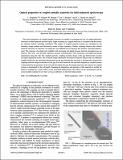Por favor, use este identificador para citar o enlazar a este item:
http://hdl.handle.net/10261/225305COMPARTIR / EXPORTAR:
 SHARE SHARE
 CORE
BASE CORE
BASE
|
|
| Visualizar otros formatos: MARC | Dublin Core | RDF | ORE | MODS | METS | DIDL | DATACITE | |

| Título: | Optical properties of coupled metallic nanorods for field-enhanced spectroscopy |
Autor: | Aizpurua, Javier CSIC ORCID ; Bryant, Garnett W.; Richter, Lee J.; García de Abajo, Francisco Javier; Kelley, Brian K.; Mallouk, T. | Fecha de publicación: | 2005 | Editor: | American Physical Society | Citación: | Physical Review B 71(23): 235420 (2005) | Resumen: | The optical properties of coupled metallic nanorods are studied to investigate the use of coupled plasmonic structures in field-enhanced spectroscopies. Light scattering by coupled nanorods is calculated with the boundary element method, including retardation. The modes of coupled nanorod systems are calculated by the boundary charge method and discussed in terms of their symmetry. Similar scattering behavior for isolated nanorods and pairs of nanorods can mask the very different local responses that produce near-field enhancement. The response of isolated rods redshifts with increasing rod length because intrarod restoring forces are reduced. The near- and far-field responses increase monotonically with increasing rod length (increasing polarization along the rod). For coupled nanorods, coupling localizes charge at the gap between the rod ends and splits degenerate modes. The localized charge depolarizes the intrarod response and provides an additional redshift. Moreover, the near-field enhancement in the gap between the nanorods is dramatically increased by coupling-induced charge localization at the gap. For short nanorods, the near-field response in coupled systems is determined by the geometry of the rod ends that define the gap. For longer nanorods, the response in coupled systems is determined by the rod length. Changing the dimensions and geometry of the nanorods to modify the interrod coupling has a major effect on the local-field enhancement. The effects of the environment and the actual metallic material do not have as big an influence on the field enhancement. | Versión del editor: | https://doi.org/10.1103/PhysRevB.71.235420 | URI: | http://hdl.handle.net/10261/225305 | DOI: | 10.1103/PhysRevB.71.235420 | ISSN: | 2469-9950 |
| Aparece en las colecciones: | (CFM) Artículos |
Ficheros en este ítem:
| Fichero | Descripción | Tamaño | Formato | |
|---|---|---|---|---|
| opticspec.pdf | 806,49 kB | Adobe PDF |  Visualizar/Abrir |
CORE Recommender
SCOPUSTM
Citations
560
checked on 20-abr-2024
WEB OF SCIENCETM
Citations
523
checked on 28-feb-2024
Page view(s)
101
checked on 24-abr-2024
Download(s)
324
checked on 24-abr-2024
Google ScholarTM
Check
Altmetric
Altmetric
Este item está licenciado bajo una Licencia Creative Commons

